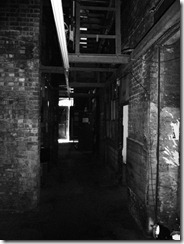I raced into the #futurising conference room 20 minutes late, having arrived 10 minutes early. Except that I wasn’t late because the organisers had thoughtfully put the talk back 10 minutes, and the presenter was still trying to get something to work. I turned to a fella behind me. “That was the slowest moving queue I’ve ever been in.”, I said. “And I’m still early!”

I could see what he meant. The officials were amiably efficient, but in an other-worldly sort of way. I’m used to conferences where there are people in power suits holding clipboards, timing everything to the second and then flapping when there is a delay. This was more like being part of one of those runny water colours you see in the Tate Gallery or along the Bayswater Road.
But despite that, or probably because of it, the conference worked. It was interesting, “edgy” and, by all accounts from looking at the tweets, useful. But I think a large part of its success was down to the venue.
The Nicholls & Clarke Building in London used to be a Victorian warehouse, which was used as a workplace until just a few years ago. One of the buildings used to be two separate ones, with a narrow alley between them. This is known as “Ripper Alley”, as it was thought to be one of the routes used by Jack the Ripper. You can see how dark and terrifying London once was: look at the pictures and shudder. This was once an external window
This was once an external window
The thing about buildings, as anyone involved in designing learning spaces will tell you, is that the nature of the design affects the nature and quality of the activities that go on inside it. We all know this, intuitively if nothing else, and yet we keep insisting on holding ICT conferences in ordinary, traditional venues. How can you think out of the box if you’re sitting in one?
Most of us are familiar with Marshall McLuhan’s "The Medium is the Message". Might it not also be the case that the venue is the message too?
There are more photos on Flickr.
